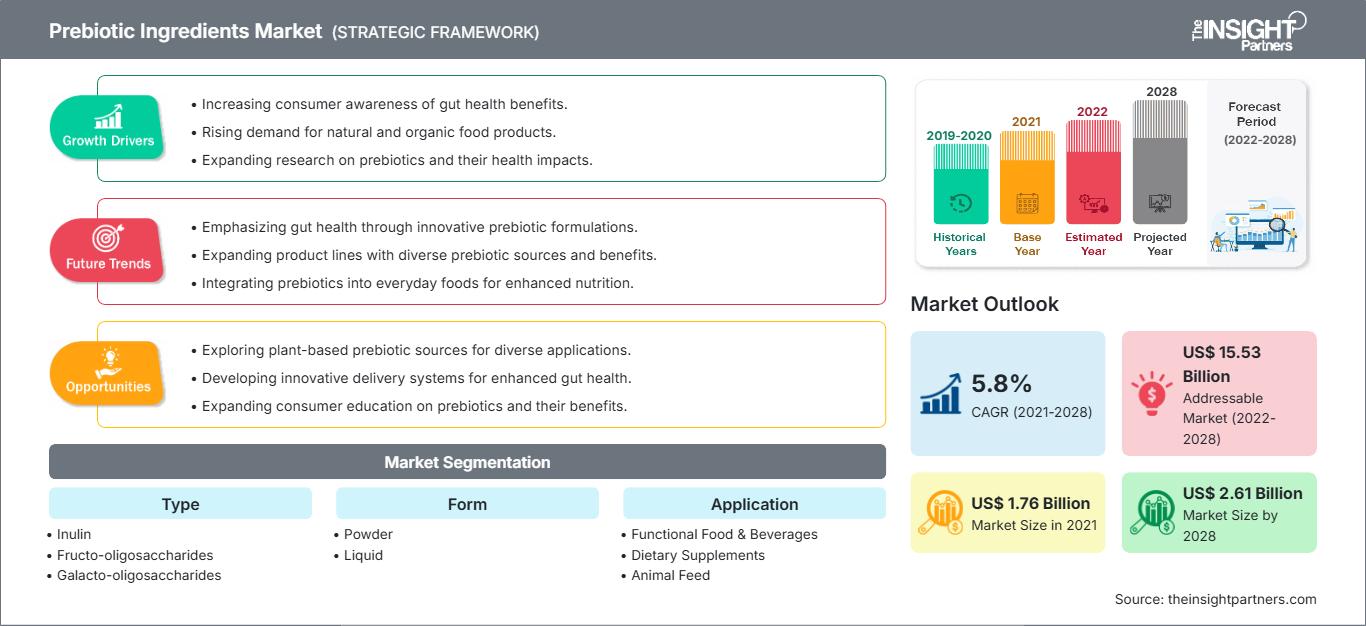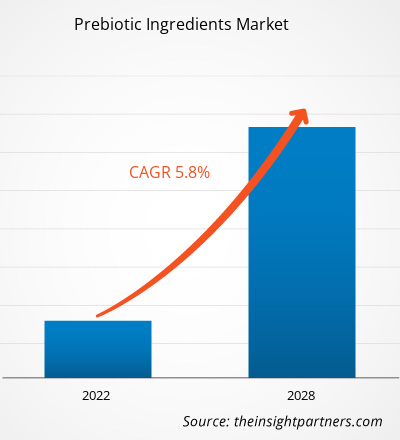[Forschungsbericht]Der Markt für präbiotische Inhaltsstoffe soll von 1.758,40 Millionen US-Dollar im Jahr 2021 auf 2.607,72 Millionen US-Dollar im Jahr 2028 wachsen; von 2022 bis 2028 wird mit einer durchschnittlichen jährlichen Wachstumsrate von 5,8 % gerechnet.
Präbiotika sind Verbindungen in Lebensmitteln, die das Wachstum oder die Aktivität nützlicher Mikroorganismen wie Bakterien und Pilze fördern. Fermentation ist der Hauptwirkungsmechanismus, durch den nützliche Bakterien Präbiotika im Dickdarm nutzen. Präbiotika spielen eine wichtige Rolle in der präventiven Gesundheitsfürsorge, da die steigende Beliebtheit ballaststoffreicher Nahrungsergänzungsmittel bei Sportbegeisterten und Athleten zur Steigerung von Ausdauer und Durchhaltevermögen die Nachfrage nach präbiotischen Inhaltsstoffen weiter steigert. Das steigende Bewusstsein für präventive Gesundheitsfürsorge fördert das Marktwachstum für präbiotische Inhaltsstoffe.
Der asiatisch-pazifische Raum hatte 2021 den größten Marktanteil an präbiotischen Inhaltsstoffen, während andere Entwicklungsregionen wie der Nahe Osten und Afrika im Prognosezeitraum voraussichtlich deutlich wachsen werden. Das Marktwachstum wird auf die zunehmende Darmgesundheit und Immunschwäche sowie die Zunahme von Verdauungskrankheiten zurückgeführt. Die asiatischen Länder tendieren dazu, gesunde und nahrhafte Lebensmittel und Getränke zu sich zu nehmen, um die Darmgesundheit zu verbessern. Daher treibt die Tendenz zu gesunder Ernährung das Wachstum des Marktes für präbiotische Inhaltsstoffe voran.
Passen Sie diesen Bericht Ihren Anforderungen an
Sie erhalten kostenlos Anpassungen an jedem Bericht, einschließlich Teilen dieses Berichts oder einer Analyse auf Länderebene, eines Excel-Datenpakets sowie tolle Angebote und Rabatte für Start-ups und Universitäten.
Markt für präbiotische Inhaltsstoffe: Strategische Einblicke

- Holen Sie sich die wichtigsten Markttrends aus diesem Bericht.Dieses KOSTENLOSE Beispiel umfasst Datenanalysen, die von Markttrends bis hin zu Schätzungen und Prognosen reichen.
Sie erhalten kostenlos Anpassungen an jedem Bericht, einschließlich Teilen dieses Berichts oder einer Analyse auf Länderebene, eines Excel-Datenpakets sowie tolle Angebote und Rabatte für Start-ups und Universitäten.
Markt für präbiotische Inhaltsstoffe: Strategische Einblicke

- Holen Sie sich die wichtigsten Markttrends aus diesem Bericht.Dieses KOSTENLOSE Beispiel umfasst Datenanalysen, die von Markttrends bis hin zu Schätzungen und Prognosen reichen.
Auswirkungen der COVID-19-Pandemie auf den Markt für präbiotische Inhaltsstoffe
Die COVID-19-Pandemie stellte Anfang 2020 viele Sektoren vor beispiellose Herausforderungen. Lockdowns, Grenzbeschränkungen, Reiseverbote, Produktionseinstellungen und andere Sicherheitsmaßnahmen, die von Regierungen gemäß den Richtlinien der WHO und der nationalen Gesundheitsministerien eingeführt wurden, behinderten die Produktionsabläufe. Der COVID-19-Ausbruch wirkte sich jedoch positiv auf den Markt aus, da Verbraucher zunehmend nach natürlichen und sichereren Alternativen suchten, um gesund zu bleiben und ihr Immunsystem zu stärken. Die Nachfrage nach Nahrungsergänzungsmitteln stieg in den ersten Monaten der COVID-19-Pandemie dramatisch an. Da die Menschen aufgrund der Regierungsauflagen zu Hause blieben, konzentrierten sie sich auf ihre Gesundheit und Fitness, was die Nachfrage nach Präbiotika während der COVID-19-Pandemie ankurbelte.
Markteinblicke
Steigende Nachfrage nach präbiotischen Inhaltsstoffen in Lebensmitteln und Getränkesektor
Präbiotika erfreuen sich in der Lebensmittel- und Getränkeindustrie zunehmender Beliebtheit, da sie in Nährstoffriegeln, Milchprodukten, Gesundheitsgetränken, Mineralstoffpräparaten, Frühstückszerealien, Backwaren, Süßwaren, grünen Lebensmitteln und Säuglingsanfangsnahrung verwendet werden. Im November 2018 brachte Kellogg Company unter dem Markennamen HI! Happy Inside ein neues Müsli mit Präbiotika und Probiotika als Teil seiner Reihe von darmstärkenden Verdauungsprodukten auf den Markt. Darüber hinaus wird Inulin häufig in der Lebensmittelverarbeitung verwendet, da es ein guter und gesunder Ersatz für Fett und Zucker ist. Große Milch produzierende Länder wie die USA, Indien und China verwenden Präbiotika, um den Endprodukten die gewünschte Textur zu verleihen und zuckerfreie Milchprodukte herzustellen. Außerdem enthält Säuglingsanfangsnahrung oder Babynahrung verschiedene präbiotische Inhaltsstoffe, darunter Galactooligosaccharide, Fructooligosaccharide und Polydextrose. Dies sind die Faktoren, die das Wachstum des Marktes für präbiotische Inhaltsstoffe vorantreiben.
Typbasierte Erkenntnisse
Basierend auf dem Typ ist der Markt für präbiotische Inhaltsstoffe in Inulin, Fructooligosaccharide (FOS), Galactooligosaccharide (GOS), Mannan-Oligosaccharide (MOS) und andere segmentiert. Das Inulin-Segment wird im Prognosezeitraum voraussichtlich den größten Anteil ausmachen. Hersteller verwenden es in verarbeiteten Lebensmitteln und Getränken, Nahrungsergänzungsmitteln und Tierfutter als Ersatz für Zucker, Fett und Mehl. In den USA hat die Food and Drug Administration Inulin 2018 als Ballaststoffzutat zugelassen, um den Nährwert von verarbeiteten Lebensmitteln zu verbessern. Darüber hinaus erhöht die steigende Nachfrage nach Naturprodukten die Nachfrage nach präbiotischem Inulin weltweit. Das Wachstum des Inulin-Segments wird durch die zunehmende Anwendung in verschiedenen Branchen vorangetrieben, was das Wachstum des Marktes für präbiotische Inhaltsstoffe befeuert.
Formbasierte Erkenntnisse
Basierend auf der Form ist der Markt für präbiotische Inhaltsstoffe in Pulver und Flüssigkeiten segmentiert. Das Pulversegment wird im Prognosezeitraum voraussichtlich eine höhere CAGR im Markt verzeichnen. Die Pulverform erleichtert die Verteilung und Nutzung des Präbiotikumkonsums. Die Verwendung von präbiotischem Pulver in der Viehzucht wird immer beliebter, da die pulverförmigen Präbiotika in jedem Lebensstadium des Viehs konsumiert werden können. Auch die zunehmende Produktivität von Fleisch, Eiern und Milch erhöht die Nachfrage nach pulverförmigen Präbiotika.
Anwendungsbasierte Erkenntnisse
Basierend auf der Anwendung ist der Markt für präbiotische Inhaltsstoffe in funktionelle Lebensmittel und Getränke, Nahrungsergänzungsmittel, Tierfutter und Sonstiges segmentiert. Das Segment Nahrungsergänzungsmittel wird im Prognosezeitraum voraussichtlich die höchste CAGR im Markt verzeichnen. Die steigende Nachfrage nach Präventivmedikamenten, die zunehmende Zahl von Verdauungsbeschwerden bei älteren Menschen und der Mangel an ausgewogener Ernährung dürften die Produktnachfrage in der Nahrungsergänzungsmittelbranche erhöhen. Verbraucher bevorzugen aufgrund der zunehmenden Verbreitung ungesunder Ernährung zunehmend präbiotikabasierte Nahrungsergänzungsmittel.
Die wichtigsten Akteure auf dem Markt für präbiotische Inhaltsstoffe sind BENEO GmbH; COSUCRA; DuPont Nutrition & Biosciences; Clasado Ltd.; Nexira; Ingredion Incorporated; SOLACTIS; Cargill, Incorporated.; Sensus; und Roquette Frères. Diese Akteure entwickeln Produkte mit reduzierten Gesundheitsrisiken, um auf neue Verbrauchertrends zu reagieren und gesetzliche Rahmenbedingungen einzuhalten. Sie sind an Fusionen und Übernahmen, Geschäftserweiterungen und Partnerschaften beteiligt, um ihren Marktanteil auszubauen.
Präbiotische InhaltsstoffeRegionale Einblicke in den Markt für präbiotische Inhaltsstoffe
Regionale Einblicke in den Markt für präbiotische Inhaltsstoffe
Die Analysten von The Insight Partners haben die regionalen Trends und Faktoren, die den Markt für präbiotische Inhaltsstoffe im Prognosezeitraum beeinflussen, ausführlich erläutert. In diesem Abschnitt werden auch die Marktsegmente und die geografische Lage in Nordamerika, Europa, dem asiatisch-pazifischen Raum, dem Nahen Osten und Afrika sowie Süd- und Mittelamerika erörtert.
Umfang des Marktberichts zu präbiotischen Inhaltsstoffen
| Berichtsattribut | Einzelheiten |
|---|---|
| Marktgröße in 2021 | US$ 1.76 Billion |
| Marktgröße nach 2028 | US$ 2.61 Billion |
| Globale CAGR (2021 - 2028) | 5.8% |
| Historische Daten | 2019-2020 |
| Prognosezeitraum | 2022-2028 |
| Abgedeckte Segmente |
By Typ
|
| Abgedeckte Regionen und Länder | Nordamerika
|
| Marktführer und wichtige Unternehmensprofile |
|
Dichte der Marktteilnehmer für präbiotische Inhaltsstoffe: Verständnis ihrer Auswirkungen auf die Geschäftsdynamik
Der Markt für präbiotische Inhaltsstoffe wächst rasant. Die steigende Nachfrage der Endverbraucher ist auf Faktoren wie veränderte Verbraucherpräferenzen, technologische Fortschritte und ein stärkeres Bewusstsein für die Produktvorteile zurückzuführen. Mit der steigenden Nachfrage erweitern Unternehmen ihr Angebot, entwickeln Innovationen, um den Bedürfnissen der Verbraucher gerecht zu werden, und nutzen neue Trends, was das Marktwachstum weiter ankurbelt.

- Holen Sie sich die Markt für präbiotische Inhaltsstoffe Übersicht der wichtigsten Akteure
Bericht-Spotlights
- Fortschreitende Branchentrends im Markt für präbiotische Inhaltsstoffe, die den Akteuren bei der Entwicklung effektiver langfristiger Strategien helfen
- Geschäftswachstumsstrategien zur Sicherung des Wachstums in entwickelten und sich entwickelnden Märkten
- Quantitative Analyse des Marktes für präbiotische Inhaltsstoffe von 2022 bis 2028
- Schätzung der weltweiten Nachfrage nach Probiotika
- Porters Fünf-Kräfte-Analyse zur Veranschaulichung der Wirksamkeit von Käufern und Lieferanten in der Branche
- Jüngste Entwicklungen zum Verständnis des wettbewerbsorientierten Marktszenarios
- Markttrends und -aussichten sowie Faktoren, die das Wachstum des Marktes für präbiotische Inhaltsstoffe bestimmen
- Unterstützung im Entscheidungsprozess durch Hervorhebung von Marktstrategien, die das kommerzielle Interesse untermauern und zum Marktwachstum führen
- Größe des Marktes für präbiotische Inhaltsstoffe an verschiedenen Knotenpunkten
- Detaillierte Übersicht und Segmentierung des Marktes und der Probiotika-Branche Dynamik
- Größe des Wachstums in verschiedenen Regionen mit vielversprechenden Wachstumschancen
- Historische Analyse (2 Jahre), Basisjahr, Prognose (7 Jahre) mit CAGR
- PEST- und SWOT-Analyse
- Marktgröße Wert/Volumen – Global, Regional, Land
- Branchen- und Wettbewerbslandschaft
- Excel-Datensatz
Aktuelle Berichte
Verwandte Berichte
Erfahrungsberichte
Grund zum Kauf
- Fundierte Entscheidungsfindung
- Marktdynamik verstehen
- Wettbewerbsanalyse
- Kundeneinblicke
- Marktprognosen
- Risikominimierung
- Strategische Planung
- Investitionsbegründung
- Identifizierung neuer Märkte
- Verbesserung von Marketingstrategien
- Steigerung der Betriebseffizienz
- Anpassung an regulatorische Trends






















 Kostenlose Probe anfordern für - Markt für präbiotische Inhaltsstoffe
Kostenlose Probe anfordern für - Markt für präbiotische Inhaltsstoffe